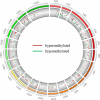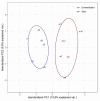Early fish domestication affects methylation of key genes involved in the rapid onset of the farmed phenotype
- PMID: 35006036
- PMCID: PMC9542679
- DOI: 10.1080/15592294.2021.2017554
Early fish domestication affects methylation of key genes involved in the rapid onset of the farmed phenotype
Abstract
Animal domestication is a process of environmental modulation and artificial selection leading to permanent phenotypic modifications. Recent studies showed that phenotypic changes occur very early in domestication, i.e., within the first generation in captivity, which raises the hypothesis that epigenetic mechanisms may play a critical role on the early onset of the domestic phenotype. In this context, we applied reduced representation bisulphite sequencing to compare methylation profiles between wild Nile tilapia females and their offspring reared under farmed conditions. Approximately 700 differentially methylated CpG sites were found, many of them associated not only with genes involved in muscle growth, immunity, autophagy and diet response but also related to epigenetic mechanisms, such as RNA methylation and histone modifications. This bottom-up approach showed that the phenotypic traits often related to domestic animals (e.g., higher growth rate and different immune status) may be regulated epigenetically and prior to artificial selection on gene sequences. Moreover, it revealed the importance of diet in this process, as reflected by differential methylation patterns in genes critical to fat metabolism. Finally, our study highlighted that the TGF-β1 signalling pathway may regulate and be regulated by several differentially methylated CpG-associated genes. This could be an important and multifunctional component in promoting adaptation of fish to a domestic environment while modulating growth and immunity-related traits.
Keywords: DNA methylation; Domestication; Oreochromis niloticus; epigenetics; muscle growth.
Conflict of interest statement
No potential conflict of interest was reported by the author(s).
Figures








Similar articles
-
Major gene expression changes and epigenetic remodelling in Nile tilapia muscle after just one generation of domestication.Epigenetics. 2020 Oct;15(10):1052-1067. doi: 10.1080/15592294.2020.1748914. Epub 2020 Apr 7. Epigenetics. 2020. PMID: 32264748 Free PMC article.
-
Differences in the fast muscle methylome provide insight into sex-specific epigenetic regulation of growth in Nile tilapia during early stages of domestication.Epigenetics. 2019 Aug;14(8):818-836. doi: 10.1080/15592294.2019.1618164. Epub 2019 May 25. Epigenetics. 2019. PMID: 31131688 Free PMC article.
-
DNA Methylation Changes in the Sperm of Captive-Reared Fish: A Route to Epigenetic Introgression in Wild Populations.Mol Biol Evol. 2019 Oct 1;36(10):2205-2211. doi: 10.1093/molbev/msz135. Mol Biol Evol. 2019. PMID: 31180510 Free PMC article.
-
Age-associated epigenetic changes in mammalian sperm: implications for offspring health and development.Hum Reprod Update. 2023 Jan 5;29(1):24-44. doi: 10.1093/humupd/dmac033. Hum Reprod Update. 2023. PMID: 36066418 Free PMC article. Review.
-
Phenotype transition from wild mouflon to domestic sheep.Genet Sel Evol. 2024 Jan 2;56(1):1. doi: 10.1186/s12711-023-00871-6. Genet Sel Evol. 2024. PMID: 38166592 Free PMC article. Review.
Cited by
-
Sperm DNA methylation landscape and its links to male fertility in a non-model teleost using EM-seq.Heredity (Edinb). 2025 May;134(5):293-305. doi: 10.1038/s41437-025-00756-y. Epub 2025 Mar 18. Heredity (Edinb). 2025. PMID: 40097595 Free PMC article.
-
Broodstock nutritional programming differentially affects the hepatic transcriptome and genome-wide DNA methylome of farmed gilthead sea bream (Sparus aurata) depending on genetic background.BMC Genomics. 2023 Nov 7;24(1):670. doi: 10.1186/s12864-023-09759-7. BMC Genomics. 2023. PMID: 37936076 Free PMC article.
-
Epigenetic changes in pyloric caeca of Atlantic salmon fed diets containing increasing levels of lipids and choline.Epigenetics. 2024 Dec;19(1):2305079. doi: 10.1080/15592294.2024.2305079. Epub 2024 Jan 28. Epigenetics. 2024. PMID: 38281164 Free PMC article.
-
Fish as Model Systems to Study Epigenetic Drivers in Human Self-Domestication and Neurodevelopmental Cognitive Disorders.Genes (Basel). 2022 May 31;13(6):987. doi: 10.3390/genes13060987. Genes (Basel). 2022. PMID: 35741749 Free PMC article.
-
Parallel Selection in Domesticated Atlantic Salmon from Divergent Founders Including on Whole-Genome Duplication-derived Homeologous Regions.Genome Biol Evol. 2025 Apr 3;17(4):evaf063. doi: 10.1093/gbe/evaf063. Genome Biol Evol. 2025. PMID: 40247730 Free PMC article.
References
-
- Price EO. Domestication defined Price, EO. In: Animal domestication and behavior. New York: CABI Publishing; 2002. p. 10–12. ISBN: 0-85199-597-7.
-
- de Mestral LG, Herbinger CM. Reduction in antipredator response detected between first and second generations of endangered juvenile Atlantic salmon Salmo salar in a captive breeding and rearing programme. J Fish Biol. 2013;83(5):1268–1286. - PubMed
-
- Agnvall B, Bélteky J, Katajamaa R, et al. Is evolution of domestication driven by tameness? A selective review with focus on chickens. Appl Anim Behav Sci. 2018;205:227–233.
Publication types
MeSH terms
Substances
LinkOut - more resources
Full Text Sources
